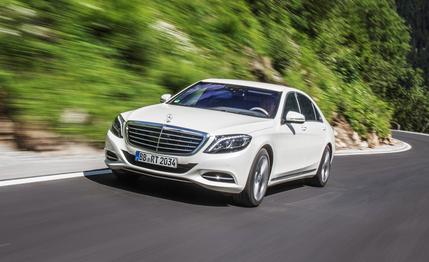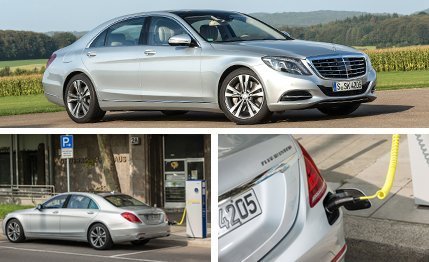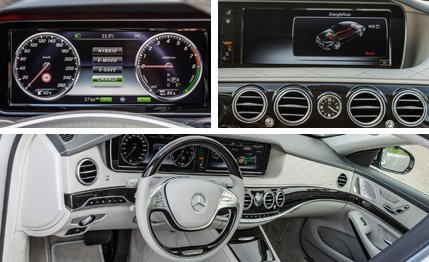
 First Drive Review
First Drive Review
Just 22 years ago, the Mercedes-Benz S-class exceeded 400 horses for the first time, with the 402-hp 6.0-liter V-12 in the 1992 600SEL besting the BMW 750i by more than 100 horsepower. The car was a gauntlet fired into the turf, and it instantly became one of the most prestigious, high-performance sedans in the world.
These days, all it takes is a 3.0-liter V-6 and an electric motor to comfortably exceed 400 horsepower in the form of the 436-hp Mercedes-Benz S550 plug-in hybrid. The company plans to market electrification as the new, prestigious must-have feature.
This plug-in hybrid will come to market in California in the second quarter of 2015 and in the rest of the U.S. in 2016. It looks amazing on paper. The 114-hp electric motor is integrated inside the seven-speed automatic, and it is powerful enough to propel this S-class to 87 mph on electricity only. Using a light touch on the accelerator, it can go for 20 miles on a full charge before the direct-injected, twin-turbocharged 329-hp V-6 kicks in. We estimate that the hybrid powertrain will hurl the big Benz to 60 mph in 5.2 seconds. Top speed is governed at 130 mph for the U.S., but it'll do 155 mph in Europe. In the very optimistic European cycle for plug-in hybrids, which involves a lot of city and not much highway driving, it is rated at 84 mpg. Figure on 26 mpg highway when it’s rated by the EPA.


But as with every plug-in hybrid, mileage will vary wildly according to driving habits. If your commute is just a few miles, a tank of gas could conceivably last for months. (We estimate 21 mpg in normal city driving, disregarding the electric-only range.) The efficiency of the plug-in is highest in city traffic, as the car can recuperate energy during braking and coasting. But if the S-class is used as a long-distance cruiser, mileage likely won't be all that different from a gas-only car.
The S550 plug-in hybrid features several drive modes, including Hybrid, E-Save, and Charge. Hybrid is the most efficient, and it can be further enhanced by using the E+ transmission mode, where the car employs the radar system to begin recuperating battery charge more strongly when approaching another car from behind. The gas pedal gives the driver’s accelerator foot a haptic buzz when it’s prudent to lift. The E-Save mode runs the gas engine just enough to keep the battery at its current state of charge, while the Charge mode fires up the V-6 more extensively to top off the battery.
We suspect that the inefficient Charge mode will be used a lot. Daimler execs agree and wonder if some S-class buyers won’t even bother plugging in the vehicle at night. That's why they have teamed up with BMW to develop a wireless, inductive-charging system. With this system, all the driver has to do is park over the charger. It could come to market within two years.
Plugging in, however, is not the only inconvenience associated with this hybrid. The 8.7-kWh lithium-ion battery steals trunk space, reducing its capacity from 18.7 to 13.9 cubic feet (according to European measurement methods, at least). And the plug-in Benz loses some of its handling edge: The extra weight of the batteries, electric motor, control units, and associated cables amounts to some 650 pounds, which makes the car feel more cumbersome during fast cornering.


Even though Daimler promises "V-8 performance at four-cylinder efficiency," the somewhat ambitiously named S550 plug-in hybrid is no match for the nonhybrid S550 with its ultrasmooth, twin-turbocharged 4.7-liter V-8. When pushed, the V-6 sounds strained, and the car doesn't offer the linear response of nonhybrids. Braking feel suffers from incorporating energy regeneration: Upon initial pedal application, the tip-in is abrupt, and the pedal feels spongy thereafter.
Everything else that makes the S-class such a fantastic car is present and accounted for, however. The cabin is an oasis of luxury and comfort. A vast array of telematics and assistance systems makes sure the driver is safe, pampered, and fully informed.
The S550 plug-in hybrid is a triumph of technology, and with fuel-economy requirements increasing rapidly, Mercedes needs as many of them on the road as possible. The carmaker calls the S550 plug-in hybrid "the smartest luxury sedan in the world" but continues to offer the S-class with conventional V-8 and V-12 powertrains. And for good reason: For a large percentage of luxury-car buyers seeking the ultimate in luxury and performance, there is still no replacement for displacement.